|
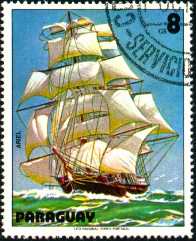
|
Maritime Topics On Stamps :
Clipper !
|
|
Clipper 'Ariel'
|
Sharp-built schooners and brigs called 'Baltimore Clippers' (left stamp)
appeared as privateers during the 1812-14 war between Great Britain and the
United States. With rakish masts, similar in appearance to French luggers and
frigates, they became the forerunners of the famous later clippers. Early on,
these clippers sailed as packet-ships, but with their great speed they were
ideally suited—and used—to smuggle opium and slaves as well... Hence, the
terms 'Opiumclipper' and 'Slaveclipper'.
|
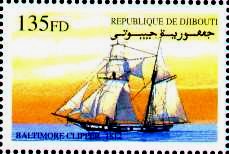
|
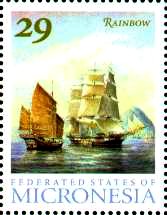
| |
The very first clipper, 'Rainbow', was designed by New York shipbuilder John
Willis Griffiths. He tested his ideas with models in water tanks. In those
days the great sailing ships had a slender stern and a round bow, which was
lifted up by each wave.
Griffiths reversed this trend by giving his designs a slender bow and
a broader stern. Especially the masts were much higher than usual. In
1845 'Rainbow' was sent on her first voyage to China to load tea
(right stamp).
|
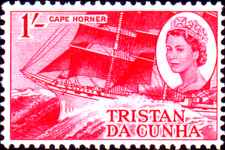
|
The word 'Clipper' originated from the verb 'to clip' and the term 'to go at
a good clip’. Typical was the elongated and concave shape of the stem, the
so-called 'clipper stem'. The ships
were deep in the water with long, slender hulls and streamlined
waterlines. Their bottoms were flat.
| |
Length to breadth ratios ranged from
5:1 to 6:1, later on with stronger steel hulls even up to 8:1. Due to these
extreme ratios these later ships were often called 'Extreme Clippers'.
| |
Most clippers were three-masted full-rigged ships. Their very high masts
allowed setting an additional sky sail at the very top. Mast heights were
approximately 3/4 of the ships lengths. There were additional stay sails
and studding sails fixed on extensions spars. The last clippers set up to
seven square sails per mast, one atop the other.
|
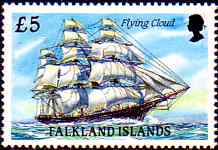
| |
This stamp represents the 'Flying Cloud', designed and built by the famous
shipbuilder Donald McKay in 1851. She had a length of 230ft, beam 41ft, draft
21ft. All clippers were able to sail at average speeds of 14 to 15 knots,
with top speeds reaching up to 20 knots.
|
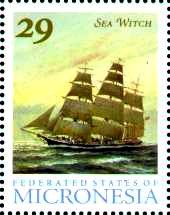
|
In those days the first steamers were built as well, but with their
coal-carrying capacities insufficient for long voyages, there was still a
need for very fast sailing ships. The first true clippers were built for the
profitable tea-trade between China and New York. Ship owners made high
profits when the fastest ships returned to New York with the first harvest of
the year. In 1849, 'Sea Witch' (see stamp) under Captain Waterman set a new
record for the passage from Hongkong to New York in just 74 days. Not much
earlier, such voyages had taken 150 to 180 days.
|
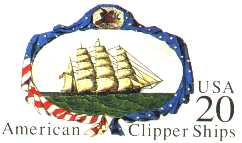
|
In 1847, thirteen vessels docked at the port of San Francisco, a settlement
with approx. 1,000 inhabitants. One year later, gold was discovered. In 1849,
775 ships reached San Francicso. There was only one clipper among them, the
'Memnon'. She had made a record run of 122 days for the passage from New York
to San Francicso. By 1849, San Francisco had attracted some 20,000 people.
| |
Costs charged for all kinds of goods had exploded tenfold. A ship, which was
able to do three round voyages per year instead of the normal two was bound
to be a gold mine as well. Immediately, clippers were taken off the tea-trade
routes to China and sent around Cape Horn.
| |
In 1850, the shipyards at New York’s East River employed 10,000 men building
new clipper ships like mad. The whole nation was under the spell of the gold
rush. And the clippers were stretched to their limits. 'Samuel Russel' needed
only 109 days, 'Sea Witch' 97 days and the 'Surprise' 96 days for the New
York - Golden Gate passage.
|
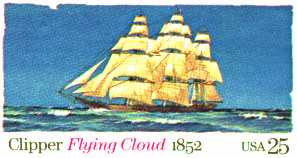
|
In 1851, 'Flying Cloud' set a new record on the New York/San Francisco run
with a time of 89 days and 21 hours, anchor to anchor, on her maiden voyage.
During the passage three spars broke in a heavy storm and sails and ropes
were torn to shreds. Yet, the crew repaired all damage within two days and
reached Frisco nearly a week faster than the previous record holder.
Three years later, in 1854, 'Flying Cloud' even eclipsed her earlier times,
establishing the absolute record for this run with 89 days and 8 hours!
During 1852-53, the three clippers 'Flying Fish', 'John Gilpin' and 'Wild
Pigeon' competed in a famous New York - San Francisco race, which was won by
'John Gilpin' in 92 days.
|
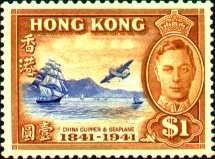
|
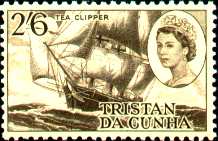
| |
In Great Britain construction of clippers started around 1851. British
ships were somewhat smaller than their American counterparts. They
were built for voyages to China, especially for the trade with tea
and opium. Since the end of the 18th century Britain transported
opium from India to China, despite Chinese efforts to block this
trade. Huge profits were accumulated and the conflict intensified. In
1840-42 the 'Opium War' between Great Britain and China resulted in the
Chinese surrender and the seizure of Hong Kong. Now China could be flooded
with opium. American and French ships took part in this evil business as
well.
On the left stamp you can see the term 'China Clipper' and to the right 'Tea
Clipper'.
|
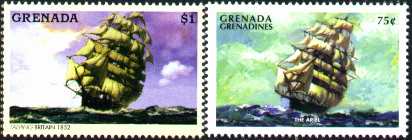
| |
Many famous races took place during the 30 years of the great clipper era.
But there was one which caused a worldwide sensation: the 'Great Tea Race' of
1866. Sixteen clippers were anchored in China, waiting for the first tea
harvest to arrive. All wanted to earn the fabulous premium awaiting the
winner, an extra ten shilling per ton. Among the sixteen, five were regarded
as favourites: 'Teaping', 'Fiery Cross', 'Taitsing', 'Serica' and 'Ariel'.
After the harvest had arrived and was loaded on board, these five clippers
were ‘flying’ through the stormy south-east trades to the Cape of Good Hope.
Ships and crews operated at their utmost limits. Breakers were constantly
washing over the decks, and two spars broke on the 'Ariel'. Then the ships
were driven northwards along the African coast, for a whole month.
After 98 days, the 'Teaping' (left stamp) and the 'Ariel' (right stamp)
came within visual range of each other, in the English Channel. On both ships
every
last piece of canvas had been set. Side by side they flew towards the mouth
of the River Thames. 'Ariel' was the first to reach her dock, leading by
eight minutes, but was unable to moore because of the low tide. Shortly
thereafter, 'Teaping' managed to go alongside and was declared the winner.
However, 'fair play' ruled and th reward was shared evenly! 'Serica'
reached London on the same tide but about1.5 hours later. Two days later,
'Fiery Cross' and 'Taitsing’ arrived in London, too.
|
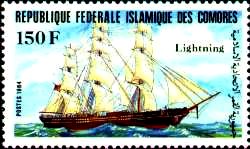
|
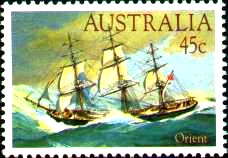
| |
In 1851 gold was found in Australia as well and crowds of gold diggers moved
‘down under’. Outward-bound 'Australian Clippers' took the route around the
Cape of the Good Hope. Homeward-bound, loaded with wool, they sailed across
the Pacific and rounded Cape Horn on the way to Europe. As the winds came
predominantly from astern, this was most favorable to the vast sail areas
carried by the clippers. A typical English clipper was the 'Orient' (right
stamp). She was built in 1853, expressly for the Australian trade.
The 'Lightning' (left stamp) was built by Donald McKay in 1854 at Boston for
James Baines & Co. of Liverpool. She and the 'James Baines' were the fastest
clippers on the Australian trade routes. Both made record passages, from
Melbourne to Liverpool in only 63 days.
'Lightning' was acclaimed to be the fastest clipper ever built. In stormy
weather she achieved 18 to 21 knots. Her main mast had a height of 164 feet;
the longest yard was 95 ft; the total length of the ship was 279 ft, beam 42
ft, draft 23 ft, deadweight 2,084 tons.
Following the opening of the Suez Channel in 1869, the China routes were
taken over by the steamers; however, clippers continued to serve on the long
routes to and from Australia.
|
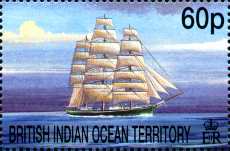
|
The British clipper 'Thermopylae' (left stamp) was launched in 1868. Her
owner, G. Thompson, claimed that she was the fastest sailing ship in the
world. She needed only 91 days for her first voyage from China to London,
impressively underlining this statement. A golden cock was fixed to the top
of her main mast to symbolize her leading role among British clippers.
Captain Jock Willis, a Scotsman, was quite annoyed by this bragging and one
year later he built the 'Cutty Sark', a ship almost identical in size
expressly to challenge the superb 'Thermopylae'.
| |
The measurements of the 'Cutty Sark' are (still today!) 272 feet length over
all, 213 ft length at waterline, 36 ft beam, 20 ft draft, 2,133 tons
deadweight. With all sails set she displayed 32,670 sqft of canvas.
|
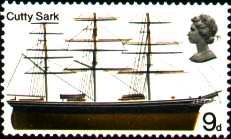
| |
On her first two voyages to the Far East 'Cutty Sark' could not match the
times of the 'Thermopylae'. On her third voyage both ships met face to face.
They left Shanghai on the same day, but 'Cutty Sark' lost her rudder during a
heavy storm in the Indian Ocean. It took four days to construct and install a
replacement rudder. The ship reached London a week later than the
'Thermopylae'. But nonetheless, crew and ship had shown a feat of outstanding
seamenship: With a jury-rigged replacement rudder, they had sailed for 7,000
nautical miles within 60 days!
The following voyages were not crowned by success either. Following eight
years in the China trade, there came five years with different cargoes on
different routes. In 1880 her masts and yards were shortened.
|
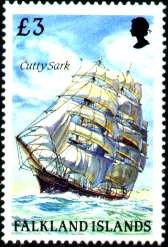
|
Then, in1885,
Captain Richard Woodgett took command, gave her a new rig, and the clipper
now entered the UK/Australia trade, to meet again her old rival
'Thermopylae'. Under her highly competent master, 'Cutty Sark' became the
fastest and most successful clipper of her days. The same year,
'Thermopylae’s time was beaten by seven days. After that, 'Cutty Sark' was
always faster than her arch-rival and past winner.
Even steamers couldn't keep up with her! In 1889 she outran the mail steamer
'Britannia' with a speed of 17 knots.
Sold to Portuguese owners in 1895, 'Cutty Sark' carried cargoes until 1922.
Then she became British again and served for a while as a stationary school
ship. In1954 she was installed in a specially constructed drydock at
Greenwich. Faithfully restored to her condition of 130 years ago, ‘Cutty
Sark’ is still there as a museum ship and as the last witness of a great era.
Anybody travelling to London should visit her.
| |
On our page about figureheads you
can read the legend of 'Nanni', the figurehead of the 'Cutty Sark',
and why she had a bunch of hairs in her outstretched hand....
There are different opinions about which sailing ship holds the record for
the longest day's run. The 'Champion of the Seas' is reported to have once
logged 465 nautical miles, at an average speed of 19.4 knots. 'Lightning' made
436 nm, averaging 18.2 knots. And in the year 1900 the Flying-P-Liner
'Potosi' reached 540 nm, an average of 22.5 knots!
However, these P-Liners, direct descendents of the clippers, are a special
chapter of sea history all by themselves.
Have a look to our
'Preussen' page ... and you will see why.
|
|